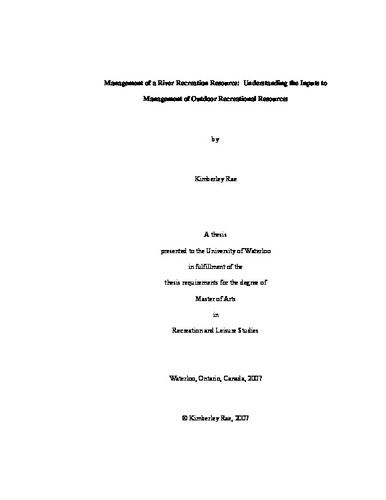| dc.description.abstract | Research into the use of natural resources and protected areas for the pursuit of outdoor recreational opportunities has been examined by a number of researchers. One activity with growth in recent years is river recreation, the use of rivers for rafting, kayaking, canoeing and instructional purposes. These many uses involve different groups of individuals, creating management complexity. Understanding the various inputs is critical for effective management The Lower Kananaskis River, located in Kananaskis Country in Southwestern Alberta, was area chosen to develop an understanding the inputs necessary for effective management. Specifically, this study explored the recreational use of the river in an effort to create recommendations on how to more effectively manage use of the Lower Kananaskis River and associated day-use facilities in the future. Kananaskis Country is a 4,250 km2 multi-use recreation area located in the Canadian Rocky Mountains on the western border of Alberta. Since its designation, the purpose of the area, has been to protect the natural features of the area while providing quality facilities that would complement recreational opportunities available in the area. Over the years, the multi-use goal of the area has led to issues surrounding the management of the recreational opportunities available, including the multiple use of the Lower Kananaskis River. The Lower Kananaskis River is a section of the larger Kananaskis River, one of six rivers flowing through Kananaskis Country. The Kananaskis River flows for 84 km. northward in the Kananaskis Country from the Upper Kananaskis Lake through the development of the Lower Kananaskis Lake and Barrier Lake to the Bow River. This thesis was only concerned about a small section of this river, the lower portion. The Lower Kananaskis River is a 2 km stretch of the river located within Bow Valley Provincial Park, with an additional 4 km of river outside of the park that many users utilize. This river has become a widely used and well-known recreational paddling destination in Kananaskis Country and Bow Valley Provincial Park and with this has come concerns over its use and management. A mixed methods approach was implemented to examine current use levels Both surveys and participant observations were used to develop a better understanding of current use levels (i.e. time, type) and to gather information from users. At the same time, structured interviews were held with key policy leaders to further explore current management issues and concerns surrounding the Lower Kananaskis River. Analysis of the data collected from river users revealed that the area is widely used by both commercial and recreational users. These two groups of users have learned to adapt to one another’s activities. Both groups expressed high level of satisfaction, but continued growth in use will probably pose problems with user’s experience and satisfaction. In many cases, users also recognized the need for improvements to river infrastructure both on and off the river. Users indicated that changes were needed in the parking areas to accommodate all of the vehicles and users, work was needed at the put-ins and take-outs to accommodate the increases in users along with work on the river features and at the day use sites. Users also recognized that the area is becoming more widely used and feel that changes are needed in how the area is maintained and managed in order to deal with its continued growth. The interviews with policy leaders emphasized the well-known nature of the issues of the area and emphasized issues within the current management structure. Policy leaders were more critical of the current management structure of the river than the users. The critical comments from the policy leaders were expected, as they are more aware of the management issues than recreational users. The policy leaders made many insightful comments for change in the interviews and recognize that park management has shown low levels of understanding and responses to the expressed needs of the users, and recommendations of previous research. This research found several examples of management ineffectiveness. It was concluded that the low levels of response from management is due to the lack of management capability. With the continued growth of the area new management demands can be expected. This in tern will require improved management framework and guideline. With this, it was recommended that increased management capability is required. In order to assist in the development of this capability the research developed an adapted outdoor recreation management framework. Application of this framework would help to ensure that the area is managed more effectively in the future. | en |

